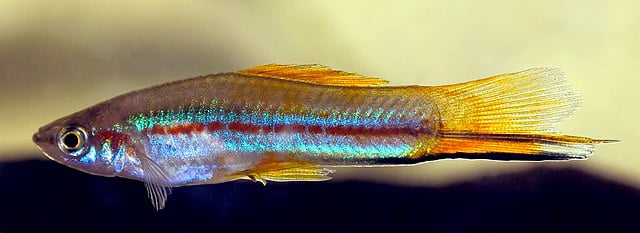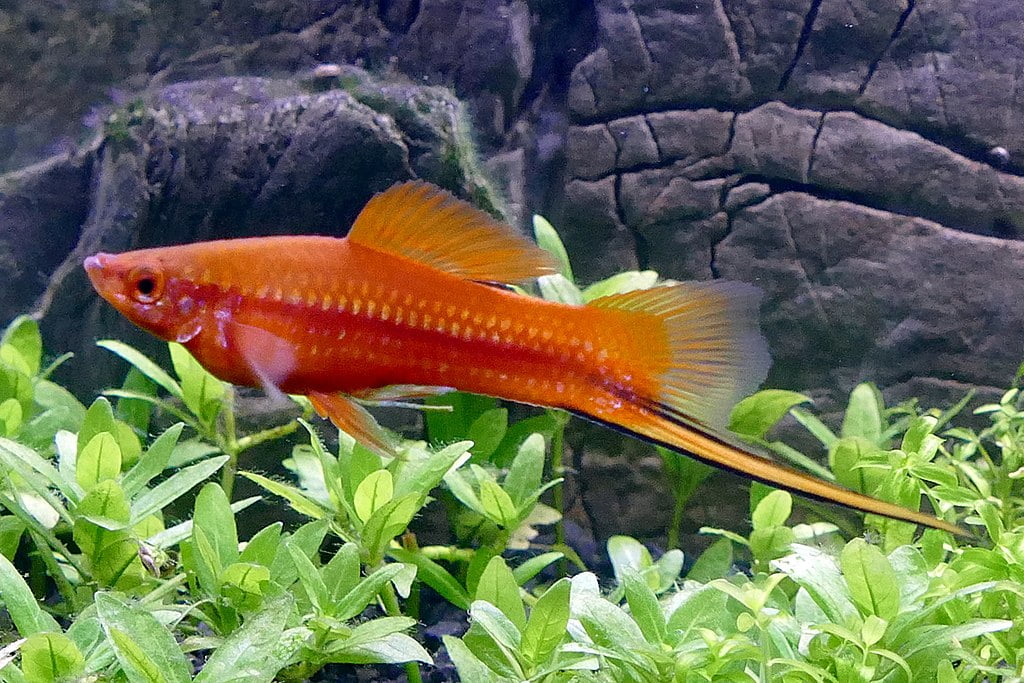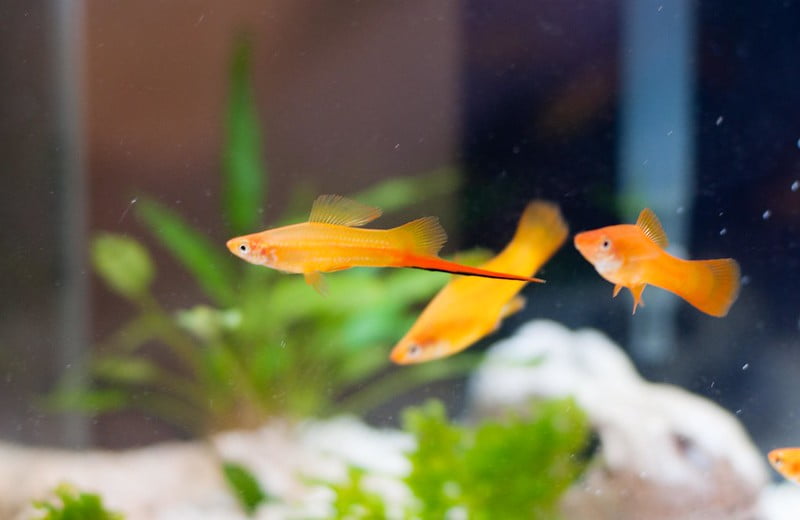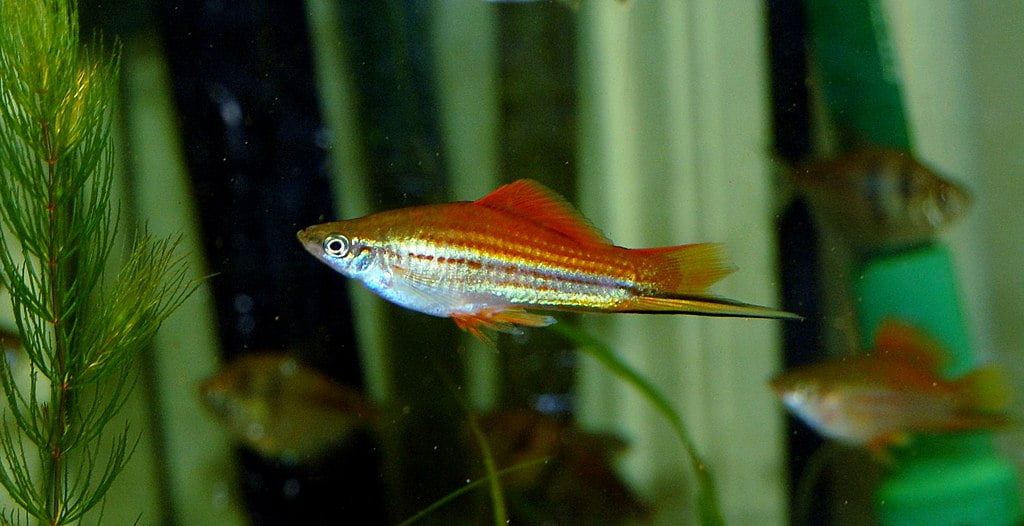As an aquarium enthusiast, you’ve probably encountered the Swordtail fish (Xiphophorus hellerii). This popular freshwater fish is a favorite among hobbyists due to its vibrant colors and unique “sword-like” tail. Belonging to the Poeciliidae family, Swordtails share close relations with other well-known aquarium dwellers like guppies, mollies, and platies.
The Swordtail fish is not a rare sight in the aquarium trade. Its popularity stems from its hardiness and ease of care, making it an excellent choice for novice and experienced aquarists. These fish come in a variety of colors, including green, red, orange, and black, with males typically boasting more vibrant hues than females.
Native to North and Central America, Swordtails thrive in diverse freshwater habitats such as rivers, streams, and ponds. In your aquarium, you’ll find them swimming at all levels, though they are generally considered mid-dwellers. Their diet is omnivorous, happily munching on flakes, pellets, frozen foods, and live foods.
One of the fascinating facts about Swordtails is their reproductive strategy. They are livebearers, meaning they give birth to live young instead of laying eggs. This trait, coupled with their relatively easy breeding, makes them a joy to watch and care for in a home aquarium.
For a bit of fun, did you know that the “sword” of the male Swordtail is actually a modified anal fin? Even more intriguing, Swordtails can change their sex. A female may change into a male if a dominant male is not present in the tank. This fascinating adaptability adds another layer of interest to these already captivating creatures.
Swordtails have a rich history in the aquarium hobby. They were first described by the German biologist Carl Heller in 1853, hence their scientific name Xiphophorus hellerii. Since then, they’ve been gracing aquariums worldwide, bringing joy and color to many homes.
As we delve deeper into the world of the Swordtail fish, we’ll explore their care requirements, and ideal tank mates, and answer some frequently asked questions. So, whether you’re a seasoned aquarist or just starting, this guide will equip you with the knowledge to provide the best care for your Swordtail fish.
Table of Contents
Price, Common Names, and Variants of Swordtail Fish
Common Names
The Swordtail fish is known by several common names in the aquarium trade. While “Swordtail” is the most widely used, it’s also referred to as Green Swordtail, Red Swordtail, or Black Swordtail, depending on its color variant. Some hobbyists might also refer to them by their scientific name, Xiphophorus hellerii.
Popular Variants
Swordtail fish come in a variety of color variants, each with its unique charm. Here are some of the most popular ones:
Green Swordtail

This variant is characterized by its vibrant green body and red or yellow stripes along the sides.
Red Swordtail

As the name suggests, this variant boasts a stunning red body, making it a standout in any aquarium.
Black Swordtail
This variant features a dark, almost black body. It’s a favorite among hobbyists looking for a fish with a dramatic appearance.
Marigold Swordtail

This variant has a beautiful mix of orange and yellow hues, reminiscent of marigold flowers.
Pineapple Swordtail

This variant is characterized by its yellow body with black spots, similar to the skin of a pineapple.
Average Price Range
The price of Swordtail fish can vary depending on factors like size, color variant, and whether they’re bred for specific traits. However, they’re generally affordable, making them a great choice for hobbyists on a budget. On average, you can expect to pay between $3 to $6 per fish. Keep in mind that prices can vary based on your location and where you’re purchasing the fish (local pet store, online, etc.).
Ideal Tank Size and Water Parameters for Swordtail Fish
Recommended Tank Size
Swordtail fish are active swimmers and require ample space to move around. The recommended tank size for these fish is at least 20 gallons for a small group. However, if you plan to keep a larger community or breed them, a larger tank of 40 gallons or more would be more suitable. Remember, a larger tank will not only provide more swimming space but also help maintain stable water parameters.
Optimal Water Temperature
Swordtail fish are tropical freshwater fish and thrive in warmer water temperatures. The optimal temperature range for these fish is between 72°F and 82°F (22°C to 28°C). Maintaining a stable temperature within this range is crucial for their health and well-being.
Ideal pH Range
Swordtails prefer slightly alkaline water conditions. The ideal pH range for these fish is between 7.0 and 8.4. Regular testing of your aquarium water will help ensure that the pH stays within this range.
Preferred Water Hardness
Swordtail fish are adaptable and can tolerate a range of water hardness levels. However, they prefer moderately hard to hard water. The recommended water hardness for Swordtails is between 12 and 30 dGH (degrees of General Hardness).
Please note that while Swordtails are hardy and can tolerate a range of water conditions, sudden changes can cause stress and health issues. Therefore, it’s essential to acclimate them slowly to new water conditions and maintain stable water parameters in your aquarium.
Lifespan and Full Size of Swordtail Fish
Average Lifespan in Captivity
Swordtail fish are known for their relatively long lifespan in captivity. On average, they can live for about 3 to 5 years. However, with optimal care and under ideal conditions, they can live even longer. It’s important to note that factors such as diet, water quality, and stress can significantly impact their lifespan.
Typical Full Size for Males and Females
Swordtail fish are medium-sized fish that can grow quite large compared to other popular aquarium species. Typically, they can reach a full size of about 5 to 6 inches in length. Interestingly, there is a noticeable size difference between males and females. Males, recognized by their distinct “sword” tail, are generally larger and more colorful than females.
Natural Environment, Behavior, and Habitat Preference of Swordtail Fish
Description of Natural Environment
Swordtail fish are native to North and Central America, where they inhabit a variety of freshwater environments. These environments include rivers, streams, and ponds, often with a moderate current. The waters they inhabit are typically clear, warm, and slightly alkaline, with a rich diversity of plant life.
Common Behaviors
Swordtails are active swimmers and are known for their peaceful temperament. They are generally mid-dwellers but can be found at all levels of the tank. Males can be territorial and may spar with each other, especially in the presence of females. Swordtails are also known for their unique reproductive behavior. They are livebearers, meaning they give birth to live young instead of laying eggs.
Preferred Habitats
In the wild, Swordtails prefer habitats with plenty of vegetation, which provides cover and a source of food. They are adaptable and can thrive in a variety of water conditions, but they prefer slightly alkaline water with moderate hardness.
Suggestions for Aquarium Decoration
To mimic their natural environment, an ideal Swordtail fish aquarium should include the following:
- Plants: Swordtails enjoy densely planted tanks. Plants not only provide cover but also contribute to a healthy water environment by absorbing nitrates.
- Rocks and Driftwood: These can provide additional hiding spots and contribute to a natural-looking environment.
- Open Swimming Space: While Swordtails appreciate the cover, they also need plenty of open space to swim.
- Substrate: A dark substrate can help mimic their natural riverbed environment and also make their colors stand out.
Choosing Tank Mates for Swordtail Fish
Swordtail fish are generally peaceful and can coexist with a variety of other fish species. However, it’s important to choose tank mates that have similar water parameter requirements and won’t bully or be bullied by the Swordtails.
List of Compatible Tank Mates
- Platies: Platies are peaceful, hardy, and share similar care requirements with Swordtails, making them an excellent choice.
- Mollies: Mollies are another good option. They are peaceful and get along well with Swordtails.
- Guppies: Guppies are small, peaceful, and can coexist well with Swordtails.
- Tetras: Many Tetras are peaceful and can make good tank mates for Swordtails. However, it’s best to avoid larger, more aggressive Tetras.
- Corydoras Catfish: These bottom dwellers are peaceful and won’t compete with Swordtails for space.
- Angelfish: Angelfish can be a good choice as long as they are not too large or aggressive.
List of Fish Species to Avoid
- Large Cichlids: Many Cichlids are aggressive and can bully or even eat Swordtails.
- Bettas: Male Bettas can be aggressive and may not get along with Swordtails.
- Barbs: Some Barbs, like Tiger Barbs, can be fin nippers and may harass Swordtails.
- Large Predatory Fish: Any fish large enough to eat a Swordtail should be avoided.
Every fish has its own personality, and individual behaviors can vary. Always monitor your tank to ensure all inhabitants are getting along. If you notice any signs of aggression or stress, it may be necessary to separate the fish.
Best Foods and Diet for Swordtail Fish
Swordtail fish are omnivores, meaning they eat a mix of plant-based and meat-based foods. They have a broad diet, which makes feeding them relatively straightforward.
List of Recommended Foods
- Flake Foods: High-quality flake foods can form the basis of Swordtail’s diet. These are readily available and come in formulations that cater to a variety of dietary needs.
- Pellets: Pellets are another good staple food. They often contain a mix of plant and animal ingredients.
- Live Foods: Swordtails enjoy live foods such as brine shrimp, daphnia, and bloodworms. These can provide essential nutrients and also stimulate the Swordtail’s natural hunting behaviors.
- Frozen Foods: Frozen foods like bloodworms, brine shrimp, and daphnia are good alternative to live foods.
- Vegetables: Swordtails also enjoy vegetables. You can offer them boiled peas, spinach, or zucchini.
Dietary Needs and Preferences
Swordtails need a balanced diet that includes both plant and animal matter. They prefer to eat at the middle and top of the water column. It’s important to feed them a variety of foods to ensure they get a range of nutrients. Overfeeding can lead to health problems, so it’s best to feed them small amounts several times a day instead of one large feeding. Always remove any uneaten food to prevent it from decaying and polluting the water.
A healthy diet is key to keeping your Swordtail fish vibrant and thriving. Always choose high-quality foods, and consider supplementing with vitamins and minerals for optimal health.
Breeding Tips for Swordtail Fish
Swordtail fish are livebearers, which means they give birth to live young instead of laying eggs. This makes their breeding process quite fascinating to observe. Here are some tips to help you successfully breed Swordtail fish:
Ideal Breeding Conditions
- Water Parameters: Maintain optimal water parameters. The water temperature should be around 75-82°F, and the pH should be slightly alkaline (7.0-8.4).
- Tank Setup: Provide plenty of hiding spots for the female and the fry. This can be achieved with dense plantings or breeding boxes.
- Diet: Feed a balanced diet rich in protein to ensure the fish are healthy and ready for breeding.
Breeding Behavior
Male Swordtails will court females by displaying their vibrant colors and impressive “sword” tail. Once the female is receptive, the male will use his gonopodium (a modified anal fin) to fertilize the female. The female can store sperm and may have several batches of fry from a single mating.
Care for Fry
- Separation: Once the fry are born, it’s recommended to separate them from the adults, as adult Swordtails may eat the fry.
- Feeding: Feed the fry several times a day with small foods like crushed flakes or specially formulated fry food. As they grow, you can gradually introduce larger foods.
- Water Quality: Maintain high water quality. Regular water changes are crucial when raising fry, as they are more sensitive to water conditions than adults.
Breeding Swordtail fish can be a rewarding experience. With the right conditions and care, you can watch your Swordtail population grow and thrive.
FAQs
How often should I feed my Swordtail fish?
Swordtail fish should be fed once or twice a day. Only provide as much food as they can eat in 2-3 minutes to prevent overfeeding and potential water quality issues.
How can I tell if my Swordtail fish is healthy?
Healthy Swordtail fish are active and have vibrant colors. Their fins should be open and not clamped. They should also have a good appetite. Signs of a sick Swordtail fish may include lethargy, loss of appetite, faded colors, erratic swimming, or visible spots or patches on the body.
Why is my Swordtail fish hiding?
Swordtail fish may hide due to stress, which can be caused by factors such as poor water conditions, bullying from other fish, or a lack of hiding spots in the tank. If your Swordtail fish is hiding, it’s important to identify and address the cause of the stress.
Can Swordtail fish live alone?
While Swordtail fish can technically survive alone, they are social creatures and generally prefer to be in groups. Keeping them in a group can help stimulate natural behaviors and make the fish feel more secure.
How can I tell the difference between male and female Swordtail fish?
Male Swordtail fish are generally larger and more colorful than females. The most distinctive feature is the “sword” – an elongated lower lobe of the tail fin, which is present in males.
Do Swordtail fish need a heater?
Yes, as tropical fish, Swordtails prefer warm water temperatures between 72°F and 82°F (22°C to 28°C). Unless your room temperature is consistently within this range, a heater is necessary to maintain the appropriate temperature.
How often should I change the water in my Swordtail fish tank?
It’s recommended to change 10-20% of the tank water weekly. Regular water changes help maintain water quality by removing waste and preventing the buildup of harmful chemicals.
What should I do if my Swordtail fish is sick?
If your Swordtail fish is showing signs of illness, it’s important to identify the cause and take appropriate action. This might involve adjusting water conditions, changing diet, or even medicating. In some cases, it may be necessary to consult with a vet or aquarium professional.
What are some common diseases that Swordtail fish can get?
Like all fish, Swordtails are susceptible to various diseases, including Ich (white spot disease), fin rot, and fungal infections. Maintaining good water quality, feeding a balanced diet, and promptly addressing any signs of an illness can help keep your Swordtail fish healthy.
Can Swordtail fish eat human food?
While Swordtail fish can eat some human foods like peas and spinach, these should only be given as treats and not as a staple diet. It’s best to feed them a balanced diet of foods specifically designed for fish, which contain the necessary nutrients they need to thrive.
Do Swordtail fish sleep?
Yes, like most fish, Swordtails do sleep. However, since they don’t have eyelids, it can be hard to tell when they’re sleeping. Generally, fish sleep is more like a rest period where they remain still and reduce their activity level.